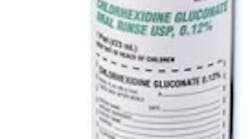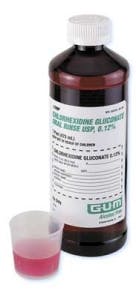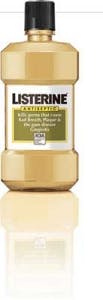By Maria Perno Goldie, RDH, MS
This section will discuss the infectious nature of the caries disease process, and how, but controlling the putative pathogens, we may be able to decrease risk of tooth decay. It is not enough to control the bacteria, we must be able to lessen risk of tooth decay. Risk assessment in general will be discussed in a future issue.
This section will discuss the infectious nature of the caries disease process, and how, but controlling the putative pathogens, we may be able to decrease risk of tooth decay. It is not enough to control the bacteria, we must be able to lessen risk of tooth decay. Risk assessment in general will be discussed in a future issue.
For an infectious disease to occur, it must have a source or reservoir, such as a person, animal, or soil. In dental caries the source may be the mother who transfers the infection to the infant, or a shared toothbrush. Potential microorganisms may be transferred directly by people or insects, or indirectly through water, air or soil. In dental caries the transfer occurs mainly through saliva. Pathogenic pathogens must survive the transfer and successfully establish within the host. In dental caries, this will take several attempts and only at specified time periods. Colonization and multiplication of the organisms may occur without evoking a tissue or immune response, as can occur in dental caries. Additionally, colonization and bacterial multiplication in dental caries is dependent upon sugar intake and other local factors.(1) In this section we will discuss the role of chlorhexidine and essential oils for control of dental caries.Infection indicates that colonization has occurred and the disease process has begun, as indicated by damage to the tissue, such as demineralization of the tooth surface. The host response will determine if there is a manifestation of the disease (demineralization). If the host response is adequate, such as the host having a healthy saliva, the individual may have the infection without the clinical manifestations of the disease. They may be a carrier, harboring the infectious agent which can be spread to others.(1) In dental caries we want to prevent dental decay by strengthening the tooth structure and altering the infectious microbes that cause dental lesions.
Chlorhexidine (CHX) is an antimicrobial ingredient in oral health care and other products. This cationic substance adheres to surfaces with a negative charge (e.g., cell walls of bacteria) and thus inhibits plaque formation and bacterial metabolism. As chlorhexidine deposits on tooth surfaces and other oral tissues, it has substantivity, ensuring sustained action against harmful oral microorganisms. CHX-containing mouth rinses have been successfully used in clinical applications for many years, primarily due to the efficacy of chlorhexidine to prevent and treat inflammation of the gingival tissues.(2)CHX is also an efficacious substance in the prevention of caries because of its antimicrobial effect. A reduction in cariogenic micoorganisms in the oral cavity leads to a decrease in the production of acids, which attack the tooth structure.(3) As a result, the development of decay may be effectively prevented using this antimicrobial in conjunction with other preventive measures. Chlorhexidine (CHX) varnish and rinses have been studied for reducing dental decay. One study concluded that CHX varnish has a moderate caries-inhibiting effect when applied every 3-4 months. However, this effect seems to have diminished by around two years after the last application.(4) A general conclusion of another study showed CHX to be effective in reducing both the number of putative dental caries pathogens and, to a lesser degree, the incidence of dental caries in the tested populations.(5) In general, CHX appeared to be moderately effective in reducing the number of putative caries pathogens in specific populations when applied under the regimen tested. CHX is also useful in reducing the consequences of these infections in that it appears to generally reduce the incidence of dental caries in the tested populations.An older study reviewed the effect of a CHX varnish mouthguard delivery system on the levels of selected oral microorganisms in caries active pediatric patients, ages four to twelve years old.(6) It was a small, double blind, placebo controlled randomized trial performed in the USA. The results showed that after two months, and after three months, there was a significant reduction in mutans streptococci (MS) levels immediately after the CHX varnish treatment. Total anaerobic and total facultative bacteria levels were not significantly affected. The conclusion was that one week of nightly use of the CHX varnish mouthguard system is effective at reducing the number of MS in caries-active pediatric patients in the mixed and primary dentition for at least three months.The effect of a 10% CHX varnish (Chlorzoin) on the mother-child transmission of Streptococcus mutans and on subsequent caries experience was studied. CHX or a placebo varnish was applied to the dentitions of 75 mothers at a time when their first babies were about 6 months old. Three more applications at weekly intervals and subsequent applications at 6-month intervals followed the initial application. The mother-child pairs were followed up until the child's fourth birthday. While maternal salivary S. mutans levels in the treatment group remained significantly lower compared to the control group up to twelve after the initial application, it did not significantly alter the S. mutans colonization in children or the caries increment in either the mother or the child.(7)
A multicentred, randomized, parallel group, double blind, placebo-controlled clinical trial compared a 10% CHX varnish treatment with placebo for preventing dental caries in adult patients with xerostomia. The difference between the 10% chlorhexidine varnish and placebo treatments was considered to be highly clinically significant for root caries increment (41% reduction) and for total caries increment (25% reduction), but only for coronal caries increment (14%).(8)A 2008 analysis on the role of CHX in caries prevention concluded that chlorhexidine should not be recommended for use in caries prevention due to the current lack of evidence for their effectiveness.(9) In several reviews, it has been concluded that the most persistent reduction of mutans streptococci have been achieved by chlorhexidine varnishes, followed by gels and, lastly, mouth rinses. For many years, the only chlorhexidine-containing products marketed in the United States (US) were mouthrinses containing 0.12 percent chlorhexidine. Based on the available reviews, chlorhexidine rinses are not highly effective in preventing caries. Because of the current lack of long-term clinical evidence for caries prevention and reported side effects, chlorhexidine rinses are not recommended for caries prevention.(9) Due to the inconclusive literature and little clinical data on gels and varnishes, their use for caries prevention should also be studied further to develop evidence-based recommendations for their clinical role in caries prevention. A systematic review concluded that evidence regarding the effectiveness of chlorhexidine varnish for preventing caries is inconclusive.(10) It also concurred with the previously sited review that further well–conducted randomized trials are required before chlorhexidine varnish can be recommended for caries prevention.Now in 2011, we have a line of products containing chlorhexidine that claim to control bacteria professionally. Cervitec is a protective varnish containing 1% chlorhexidine & 1% thymol. Cervitec Gel is a 0.2% chlorhexidine & 900 ppm fluoride for professional and at-home application. Cervitec Liquid is a mouth rinse 0.1% chlorhexidine & xylitol & essential oil. Studies supporting the claim show the antimicrobial effect of Cervitec® products on various oral microorganisms.(11)Which bring us to another question, are essential oils (EO) effective in caries prevention or control? Studies of products with EO show a significant reduction in the level of oral S. mutans provides. This provides evidence for in situ bactericidal activity, and provides rationale that daily use of an EO rinse may be indicated, as an adjunct to mechanical oral hygiene regimens.(12) A supplement provides clear evidence that EO mouthrinses can be a beneficial, safe component of daily oral health routines, and a key component in oral health management.(13) The combination of fluoride and essential oils in a mouthrinse may provide anticaries efficacy, in addition to EO’s established antigingivitis efficacy. There is evidence that an essential oil mouthrinse with 100 parts per million fluoride is effective in promoting enamel remineralization and fluoride uptake.(14)We should use established, evidence-based prevention methods, such as fluoride applications, diet modifications and good oral hygiene practices for reduction of dental decay. The effect of an antimicrobial agent for reducing the levels of mutans streptococci or plaque reduction may not always correlate with eventual caries reduction. The clinically important outcome is proven reductions in caries.References
1. Greenstein, G & Lamster, I. Bactrerial transmission in periodontal disease: A critical review. J. Periodontol. 68:421-431, 1997.2. Lorenz K, Bruhn G, Heumann C, Netuschil L, Brecx M, Hoffmann T. Effect of two new chlorhexidine mouthrinses on the development of dental plaque, gingivitis, and discolouration. A randomized, investigator-blind, placebo-controlled, 3-week experimental gingivitis study. JClin Periodontol 2006;33:561-567.3. Bizhang M, Seemann R, Romhild G, Chun YH, Umland N, Lang H, Zimmer S. Effect of a 40% chlorhexidine varnish on demineralization of dentin surfaces in situ. Vol. 20 2007.4. Zhang Q, van Palenstein Helderman WH, van't Hof MA, Truin GJ. Chlorhexidine varnish for preventing dental caries in children, adolescents and young adults: a systematic review. Eur J Oral Sci. 2006 Dec;114(6):449-55.5. Anderson MA. A Review of the Efficacy of Chlorhexidine on Dental Caries and the Caries Infection. Journal Of The California Dental Association, March 2003.6. Achong RA, Briskie DM, Hildebrandt GH, Feigal RJ, Loesche WJ. Effect of chlorhexidine varnish mouthguards on the levels of selected oral microorganisms in pediatric patients. Pediatr Dent. 1999 May-Jun;21(3):169-75.7. Dasanayake AP, Wiener HW, Li Y, Vermund SH, Caufield PW. Lack of effect of chlorhexidine varnish on Streptococcus mutans transmission and caries in mothers and children. Caries Res. 2002 Jul-Aug;36(4):288-93.8. Banting DW, Papas A, Clark CD, Proskin HM, Schultz M, Perry R. The effectiveness of 10% chlorhexidine varnish treatment on dental caries incidence in adults with dry mouth. Gerodontology, Volume 17, Issue 2, pages 67–76, December 2000.9. J. Autio-Gold (2008) The Role of Chlorhexidine in Caries Prevention. Operative Dentistry: November 2008, Vol. 33, No. 6, pp. 710-716.10. James P. The Caries-Preventive Effect of Chlorhexidine Varnish in Children and Adolescents: A Systematic Review. Caries Research , 07/09/2010. 11. Bolis C, Huwig A. Entwicklung und Charakterisierung eines Chlorhexidin und Fluoridenthaltenden Mundpflegegels. Prophylaxe Impuls 2008; 12: 126-133.12. Fine DH, Furgang D, Barnett ML, et al. Effect of an essential oil-containing antiseptic mouthrinse on plaque and salivary Streptococcus mutans levels. J Clin Periodontol. 2000;27:157-161.13. Claffey N. Essential oil mouthwashes: a key component in oral health management. J Clin Periodontol. 2003;30 Suppl 5:22-4.14. Zero DT, Zhang JZ, Harper DS, Wu M, Kelly S, Waskow J, and Hoffman M. The remineralizing effect of an essential oil fluoride mouthrinse in an intraoral caries test. J Am Dent Assoc, Vol 135, No 2, 231-237.Additional Reading
1. Prevention of caries in high risk patients Systematic Reviews ohsrc.ucc.ie/downloads/June2010/Final_Evidence__tables__high__caries_risk.pdf2. Fissure Sealants In Caries Prevention.herkules.oulu.fi/isbn9789514263422/isbn9789514263422.pdf
1. Greenstein, G & Lamster, I. Bactrerial transmission in periodontal disease: A critical review. J. Periodontol. 68:421-431, 1997.2. Lorenz K, Bruhn G, Heumann C, Netuschil L, Brecx M, Hoffmann T. Effect of two new chlorhexidine mouthrinses on the development of dental plaque, gingivitis, and discolouration. A randomized, investigator-blind, placebo-controlled, 3-week experimental gingivitis study. JClin Periodontol 2006;33:561-567.3. Bizhang M, Seemann R, Romhild G, Chun YH, Umland N, Lang H, Zimmer S. Effect of a 40% chlorhexidine varnish on demineralization of dentin surfaces in situ. Vol. 20 2007.4. Zhang Q, van Palenstein Helderman WH, van't Hof MA, Truin GJ. Chlorhexidine varnish for preventing dental caries in children, adolescents and young adults: a systematic review. Eur J Oral Sci. 2006 Dec;114(6):449-55.5. Anderson MA. A Review of the Efficacy of Chlorhexidine on Dental Caries and the Caries Infection. Journal Of The California Dental Association, March 2003.6. Achong RA, Briskie DM, Hildebrandt GH, Feigal RJ, Loesche WJ. Effect of chlorhexidine varnish mouthguards on the levels of selected oral microorganisms in pediatric patients. Pediatr Dent. 1999 May-Jun;21(3):169-75.7. Dasanayake AP, Wiener HW, Li Y, Vermund SH, Caufield PW. Lack of effect of chlorhexidine varnish on Streptococcus mutans transmission and caries in mothers and children. Caries Res. 2002 Jul-Aug;36(4):288-93.8. Banting DW, Papas A, Clark CD, Proskin HM, Schultz M, Perry R. The effectiveness of 10% chlorhexidine varnish treatment on dental caries incidence in adults with dry mouth. Gerodontology, Volume 17, Issue 2, pages 67–76, December 2000.9. J. Autio-Gold (2008) The Role of Chlorhexidine in Caries Prevention. Operative Dentistry: November 2008, Vol. 33, No. 6, pp. 710-716.10. James P. The Caries-Preventive Effect of Chlorhexidine Varnish in Children and Adolescents: A Systematic Review. Caries Research , 07/09/2010. 11. Bolis C, Huwig A. Entwicklung und Charakterisierung eines Chlorhexidin und Fluoridenthaltenden Mundpflegegels. Prophylaxe Impuls 2008; 12: 126-133.12. Fine DH, Furgang D, Barnett ML, et al. Effect of an essential oil-containing antiseptic mouthrinse on plaque and salivary Streptococcus mutans levels. J Clin Periodontol. 2000;27:157-161.13. Claffey N. Essential oil mouthwashes: a key component in oral health management. J Clin Periodontol. 2003;30 Suppl 5:22-4.14. Zero DT, Zhang JZ, Harper DS, Wu M, Kelly S, Waskow J, and Hoffman M. The remineralizing effect of an essential oil fluoride mouthrinse in an intraoral caries test. J Am Dent Assoc, Vol 135, No 2, 231-237.Additional Reading
1. Prevention of caries in high risk patients Systematic Reviews ohsrc.ucc.ie/downloads/June2010/Final_Evidence__tables__high__caries_risk.pdf2. Fissure Sealants In Caries Prevention.herkules.oulu.fi/isbn9789514263422/isbn9789514263422.pdf
Maria Perno Goldie, RDH MS










